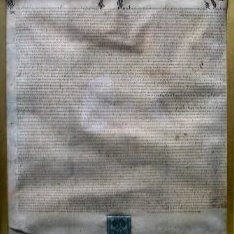
Since its inception in 1681 the College has always been subject to the terms and conditions of the current Royal Charter. Much time and effort had to be expended by our predecessors before the successful award of our first Royal Charter. Foremost among those responsible were George Sibbald and George Purves. Initial approaches were made in 1617 and subsequently in 1621, 1633 and 1656. These efforts were blocked by opposition at different stages from the Bishops, the Corporation of Surgeons, the Town Councils of Edinburgh and Glasgow and the Universities, particularly that of Aberdeen. All of these felt that their rights and privileges would be infringed by the proposed College of Physicians.
Finally Robert Sibbald, nephew of George Sibbald, with the help of the King’s High Commissioner, the Duke of York, and of Sir Charles Scarborough, the King’s First Physician, was received by Charles II, then in Edinburgh, and presented him with the Royal Warrant of James VI dated 1621 concerning the establishment of a College of Physicians in Edinburgh. Sibbald, and James VI’s signature, succeeded where others had failed, and the Charter of Erection was signed by Charles II and the great seal appended on St Andrew’s Day 1681. The following year Robert Sibbald was knighted. His portrait hangs in the Fellows Room.
A Charter of Ratification was granted by the Scottish Parliament in June 1685.
No changes in the original charter were made for nearly two centuries. The Medical Act of 1858 had many implications as far as the Royal Colleges were concerned, and after Amending Acts had been passed in 1860 the College, following considerable debate, agreed on the form of a new Royal Charter which was granted by Queen Victoria and sealed on 31 October 1681.
Changes in medical practice have progressed at such a pace during this century that four supplementary charters have been required between 1920 and 1964 to allow the College to increase its activities beyond the bounds set by the 1861 Charter.
The Report of the Royal Commission on Medical Education led to a further reassessment of the role of the College and in 1968, Dr Christopher Clayson, then President, appointed a committee which subsequently became known as the ‘Croom’ Committee after its chairman Sir John Halliday Croom, who succeeded Dr Clayson as President. The recommendations of this committee are the guidelines for present College development. Included in these was the establishment of Collegiate Membership, the first step to greater involvement of Members in the affairs of the College. In addition, other developments, including the MRCPE (UK) and the establishment of the Faculty of Community Medicine jointly by three Royal Colleges of Physicians in the UK, have necessitated a major revision of the College Laws.
Previously published in the Proceedings of the Royal College of Physicians of Edinburgh (1977), 7: 2
Author: A. J. Keay



